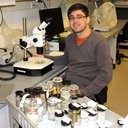Genetics of type II diabetes.
Mots clés
Abstrait
Defining the genetic basis of Type II or non-insulin dependent diabetes mellitus (NIDDM) will accelerate our progress toward understanding its etiology and will provide new therapeutic targets for treatment of this common disease. Here we present a brief overview of the history of the search for diabetes genes and report current strategies employed by our laboratory and by others in this effort. Isolation and subsequent mapping of candidate genes involved in insulin production and action has been a major effort in this field. Our lab has focused on pancreatic islet beta-cell genes, since the insulin lack of NIDDM is often the result of resistance to the action of insulin that is superimposed on a limited ability to produce insulin. A number of islet genes have been evaluated, including those involved in glucose metabolism, islet K+ channel genes, and transcription factors. For each gene, human cDNAs and genomic clones have been isolated and simple sequence repeat polymorphisms (SSRPs) identified. The SSRPs were used to map the genes by linkage in CEPH pedigrees, or sequence-tagged sites (STSs) were used to map the genes to radiation hybrids (RH) or to YAC clones containing SSRPs. The SSRPs have then been used as markers for linkage analyses in families with NIDDM. Mutation screening by single-strand conformational polymorphism analysis and by sequencing has revealed variants that have been tested in association studies. A strategy was devised to generate novel expressed sequence tags (ESTs) from human pancreatic islet genes by differential display of islet mRNA. In the first phase of this project we identified 42 cDNAs that were preferentially expressed in pancreatic islets relative to exocrine tissue. When compared to sequences in GenBank, novel genes were represented by 69%. Enhanced islet expression was confirmed by Northern analysis of RNA. Sequence-tagged sites were synthesized for a number of islet ESTs and used to map these genes to human chromosomes. This strategy provides an effective means to selectively identify and map genes transcribed in human pancreatic islets and to identify novel islet candidate genes for NIDDM. Positional cloning of NIDDM genes in families of various racial groups is being conducted by a number of labs. Although regions of genetic susceptibility are being identified, finding the genes within these regions will be difficult because of the polygenic nature of the disease As an alternative strategy, we have begun to map genes responsible for monogenic disorders of carbohydrate metabolism. Familial hyperinsulinism (HI, OMIM #256450) is a rare recessive disease associated with neonatal hyperinsulinism and life-threatening hypoglycemia. To determine the molecular basis for HI, we mapped the gene in multiplex families to chromosome 11p14-15.1. A candidate gene, the sulfonylurea receptor (SUR1), was mapped to the region and shown to harbor mutations in HI patients. Analysis of 21 identified mutations has revealed the role of SUR1 as a nucleotide regulator of the islet ATP-sensitive K+ channel. The challenge for the future will be to utilize the information provided by the Human Genome Project (i.e., the complete nucleotide sequence and expression maps of the genome) to find diabetes-predisposing genes. Our immediate goals include collecting families with NIDDM for phenotyping and for DNA analysis and continuing to identify suitable candidate genes to be studied in these families.



